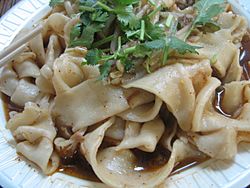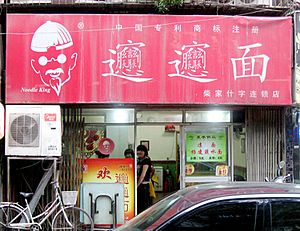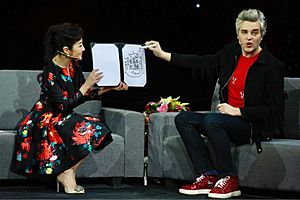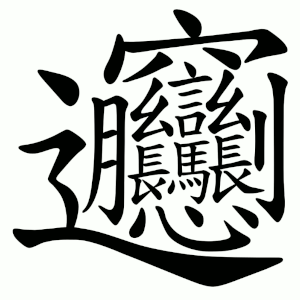Biangbiang noodles facts for kids
 |
|
| Type | Chinese noodles |
|---|---|
| Place of origin | China |
| Region or state | Shaanxi |
| Biangbiang noodles | |||||||||||||||||
|---|---|---|---|---|---|---|---|---|---|---|---|---|---|---|---|---|---|
| Traditional Chinese | 𰻞𰻞麵 / |
||||||||||||||||
| Simplified Chinese | 𰻝𰻝面 / |
||||||||||||||||
| Hanyu Pinyin | biángbiáng miàn | ||||||||||||||||
|
|||||||||||||||||
| Alternative Chinese name | |||||||||||||||||
| Traditional Chinese | 油潑扯麵 | ||||||||||||||||
| Simplified Chinese | 油泼扯面 | ||||||||||||||||
| Hanyu Pinyin | yóupō chěmiàn | ||||||||||||||||
| Literal meaning | oil-splashed hand-pulled noodles | ||||||||||||||||
|
|||||||||||||||||
Biangbiang noodles are a special type of Chinese noodle from Shaanxi province in China. People also call them youpo chemian, which means "oil-splashed hand-pulled noodles." These noodles are famous for being super thick and long, almost like a belt!
They are considered one of the "eight curiosities" of Shaanxi. What makes them even more unique is the incredibly complex Chinese character used to write biáng. This character is one of the most complicated in the world!
Contents
What are Biangbiang Noodles?
These noodles are thick and shaped like a belt. They are usually made by hand. For a long time, they were a secret dish mostly eaten in Xi'an. Workers there loved them because they were quick to make.
Recently, these noodles have become very popular across China. This is partly thanks to social media. People are fascinated by the super tricky character used to write biáng.
The word biáng itself sounds like the noodle dough hitting the table when it's being made. It's an onomatopoeic word, meaning it sounds like what it describes!
The Special Chinese Character for biáng
There are many ways to write the character for biáng. The most common traditional version has 58 strokes! A stroke is a single line you draw when writing a character. This makes it one of the most complex Chinese characters still used today.
Even though it's used, you won't find this character in most modern dictionaries. It's that special! The character is made up of many smaller parts, like "speak," "tiny," "horse," "grow," "moon," "heart," "knife," "cave," and "walk."
Using the Character on Computers
For a long time, it was hard to type or show the biáng character on computers. But good news! Both the traditional and simplified versions were added to Unicode in March 2020. Unicode is a system that allows computers to show text from different languages.
Now, the traditional form is U+30EDE (𰻞) and the simplified form is U+30EDD (𰻝). Before this, people often used pictures of the character. Or they would use other Chinese words that sounded similar, like biāobiāomiàn or bīngbīng miàn. Sometimes, they just used the pinyin (the way Chinese words are written using the English alphabet).
How to Remember the Character (Mnemonics)
People in Shaanxi province have created fun poems to help remember how to write this super complex character. These poems are called mnemonics. They help you remember things by making them into a story or song.
Here's one popular poem:
| Traditional Chinese | Simplified Chinese | Pinyin | English translation |
|---|---|---|---|
| 一點上了天 | 一点上了天 | Yīdiǎn shàngle tiān | A dot goes up to the sky, |
| 黃河兩道彎 | 黄河两道弯 | Huáng Hé liǎng dào wān | Two bends like the Yellow River. |
| 八字大張口 | 八字大张口 | Bāzì dà zhāngkǒu | The character "Eight" opens wide, |
| 言字往進走 | 言字往进走 | Yán zì wǎng jìn zǒu | The character "Speech" walks inside. |
| 你一扭 我一扭 | 你一扭 我一扭 | Nǐ yī niǔ, wǒ yī niǔ | You twist, I twist too, |
| 你一長 我一長 | 你一长 我一长 | Nǐ yī zhǎng, wǒ yī zhǎng | You grow, I grow with you, |
| 當中加個馬大王 | 当中加个马大王 | Dāngzhōng jiā gè mǎ dàwáng | In the middle, add a horse king. |
| 心字底 | 心字底 | Xīn zì dǐ | "Heart" at the bottom, |
| 月字旁 | 月字旁 | Yuè zì páng | "Moon" on the side, |
| 留個鈎搭掛麻糖 | 留个钩搭挂麻糖 | Liú ge gōu dā guà má tang | Leave a hook to hang candy, |
| 坐着車車逛咸陽 | 坐着车车逛咸阳 | Zuòzhe chēchē guàng Xiányáng | Riding a carriage to Xianyang. |
Where Did the Character Come From?

No one is completely sure how the biáng character and the noodles got their start. One story says that a famous leader from the Qin dynasty, named Li Si, invented the character. But this is probably not true, because the character isn't in old dictionaries from his time.
Some people think the character was made up by a noodle shop owner. This would explain why it's so unique and not found in official records.
Another idea is that the word "biang" simply comes from the sound the noodles make. Imagine the chef pulling the dough and slapping it on the table – "biang biang biang!" This sound then became the name of the noodles.
There's also a fun legend about a student who didn't have money to pay for his noodles. So, he invented the complex character on the spot to impress the noodle shop owner and get out of paying!
Images for kids




























